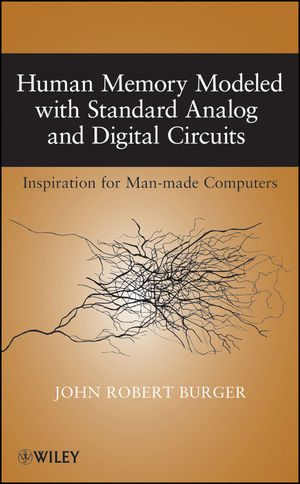Human Memory Modeled with Standard Analog and Digital Circuits: Inspiration for Man-made ComputersISBN: 978-0-470-42435-3
Hardcover
366 pages
July 2009
 This is a Print-on-Demand title. It will be printed specifically to fill your order. Please allow an additional 10-15 days delivery time. The book is not returnable.
|
||||||
1 BRAIN BEHAVIOR POINTS THE WAY.
Introduction.
Modeling.
Uses of models.
Why Thinking Dissipates So Few Calories?
The Miracle of Parallel Processing.
Singularity.
The Benefits of Reading This Book.
Overview of the Book.
Applications of the Models in the Book.
Conclusions.
Exercises.
2 NEURAL MEMBRANES AND ANIMAL ELECTRICITY.
Introduction.
The Physical Neuron.
Ionic Solutions and Stray Electrons.
Nernst Voltage.
Ion-Channel Model.
Applications.
Conclusions.
Exercises.
3 NEURAL PULSES AND NEURAL MEMORY.
Introduction.
Derivation of a Neural Pulse Using Basic Physics.
Neuron Signal Propagation.
Modeling Neurons as Adiabatic.
Neurons for Memory.
Applications.
Conclusions.
Exercises.
Appendix: Asymptotically Adiabatic Circuits.
4 CIRCUITS AND SYSTEMS FOR MEMORIZATION AND RECALL.
Introduction.
Psychological Considerations When Modeling Human Memory.
Basic Assumptions to Create A Model.
Short-Term Memory and Consciousness.
Cognitive Architecture.
Discussion of the Model.
Enable Neural Logic.
Models for Memorization.
Applications.
Conclusions.
Exercises.
5 DENDRITIC PROCESSING AND HUMAN LEARNING.
Introduction.
Biological Versus Artificial Neural Networks.
Dendrites
Neurons for Combinational Learning.
Neurons for State-Machine Learning.
Learning Circuits.
Dendritic Processing Models.
Enabled Logic Directly at the Soma.
Comments on the Adiabatic Nature of Dendrites.
Applications.
Conclusions.
Exercises.
Appendix: Circuit Simulations of Neural Soliton Propagation.
Conclusions.
6 ARTIFICIAL LEARNING IN ARTIFICIAL NEURAL NETWORKS.
Introduction.
Artificial Neurons.
Artificial Learning Methods.
Discussion of Learning Methods.
Conclusion.
Exercises.
7 THE ASSET OF REVERSIBILITY IN HUMANS AND MACHINES.
Introduction.
Savants.
Neural Models that Explain Savants.
Parallel Processing and the Savant Brain.
Computational Possibilities Using Conditional Toggle Memory.
The Cost of Computation.
Reversible Programming.
Conclusions.
Exercises.
Appendix: Split-Level Charge Recovery Logic.
8 ELECTRICALLY REVERSIBLE NANOPROCESSORS.
Introduction.
A Gauge for Classical Parallelism.
Design Rules for Electrical Reversibility.
Reversible System Architecture.
Architecture for Self-Analyzing Memory Words.
Electrically Reversible Toggle Circuit.
Reversible Addition Programming Example.
Reversible Subtraction Programming Example.
Conclusions.
Exercises.
9 MULTIPLICATION, DIVISION, AND HAMILTONIAN CIRCUITS.
Introduction.
Unsigned Multiplication.
Restoring Division.
Solving Hard Problems.
Hamiltonian Circuits.
The Initialization of Toggle Memory in Nanoprocessors.
Logically Reversible Programming Using Nanobrains.
Conclusions.
Exercises.
10 QUANTUM VERSUS CLASSICAL COMPUTING.
Introduction.
Physical Qubits.
Quantum Boolean Functions.
Quantum Computer Programming.
Historical Quantum Computing Algorithms.
Conclusions.
Exercises.
APPENDIX A HUMAN BRAIN ANATOMY.
Components of a Brain.
Forebrain Structure.
APPENDIX B THE PSYCHOLOGICAL SCIENCE OF MEMORY.
Short-Term Memory.
Long-Term Memory.
Studies in Learning.
Memory Retrieval.
Serial Reproduction.
Memory Theorists.
Dreams.
APPENDIX C BRAIN SCANNING.
Electroencephalography.
Magnetic Resonance Imaging.
Functional Magnetic Resonance Imaging.
Positron Emission Tomography.
Computerized Axial Tomography.
APPENDIX D BIOGRAPHIES OF PERSONS OF SCIENTIFIC INTEREST.
FOR FURTHER STUDY.
INDEX.



